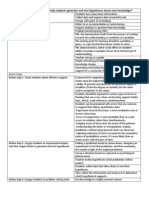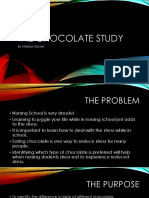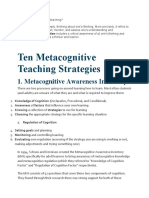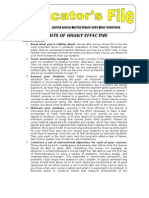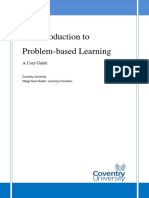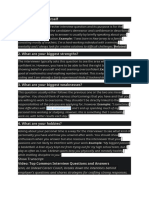Advantages of PBL: Roblem-Based Learning: PBL Is Any Learning Environment in Which The Problem Drives
Uploaded by
jeju_pinguAdvantages of PBL: Roblem-Based Learning: PBL Is Any Learning Environment in Which The Problem Drives
Uploaded by
jeju_pingulecture method
students to be passive in the classroom
relied on transcription, memorization, and repetition for learning.
This research shows that PBL provides students with the opportunity to gain theory and content
knowledge and comprehension. In addition, PBL helps students develop advanced cognitive
abilities such as critical thinking, problem solving, and communication skills. PBL also can
improve students' attitudes toward learning. Thus, as a pedagogical technique, problem-based
learning promotes the kinds of active learning that many educators advocate (Barr & Tagg,
1995).
roblem-based Learning: PBL is any learning environment in which the problem drives
the learning. That is, before students learn some knowledge they are given a
problem. The problem is posed so that the students discover that they need to learn
some new knowledge before they can solve the problem.
What skills should a student have before entering a PBL program? They should be
skilled at problem solving because that skill in needed as the students try to solve the
problem.
skilled in problem solving or critical thinking or "thinking on your feet" (as opposed
to rote recall).
Advantages of PBL
l greater recall of knowledge, retention
l interdisciplinary, can require accessing
and using information from a variety of
subject domains; better integration of
knowledge
l development of life-long learning skills:
how to research, how to communicate
in groups, how to handle problems
increased motivation, interest in subject
areas
l increased student-student interaction,
and student-instructor interaction
increased motivation, interest in subject
areas
l increased student-student interaction,
and student-instructor interaction
uring this course, you will use the PBL Model below to assess what is known,
to answer questions, and then to analyze various options before presenting a
recommendation or solution.
1. Read and analyze the scenario and situation.Check your
understanding of the scenario. Don't be tempted to start thinking about
potential solutions or to start looking for information. You will be more
effective in addressing complex scenarios by following Steps 1 through
7.
2. List hypotheses, ideas, or hunches. You will usually have some
theories or hypotheses about the cause of the problem or ideas about
how to solve the problem. These need to be listed; they will be
supported or refuted as your investigation proceeds. You will also list
many alternative conceptions that need to be addressed.
3. List what is known. If needed, print a copy of the scenario and
situation and move away from the computer. Make a list of everything
you know. You do not need to conduct any research at this point. Just
draw from your prior knowledge and the information that is included in
the scenario.
4. List what is unknown. Prepare a list of questions that you think need
to be answered to solve the problem. Several types of questions may be
appropriate. Some may address concepts or principles that need to be
learned in order to address the situation. Other questions may be in the
form of requests for more information. These questions will guide
research that may take place on the Internet/WWW, in the library, or
with other sources.
5. List what needs to be done. Plan the investigation. Such actions may
include questioning an expert, getting online data, or visiting a library to
find answers to the questions developed in Step 4. When working with a
team, divide the duties.
6. Develop a problem statement. A problem statement is a one or two
sentence idea that clearly identifies what you are trying to solve,
produce, respond to, test, or find out. In more complex situations, you
may have to begin Step 7, then consider the emerging information in
order to complete Step 6. Keep in mind that the problem statement may
have to be revised as new information is discovered and brought to bear
on the situation. Developing a Problem Statement
7. Gather information. You will gather, organize, analyze, and interpret
information from multiple sources. Exchange ideas; think about
solutions; weigh alternatives; and consider the pros and cons of
potential courses of action. As more information is gathered, the
problem statement may be refined or altered. Or, based upon your
research data, a recommended solution or opinion may be appropriate.
8. Present findings. Prepare a report or presentation in which you make
recommendations, predictions, inferences, or other appropriate
resolutions of the problem. Be prepared to support the positions you
take. If appropriate, consider a multimedia presentation using images,
graphics, or sound.
In PBL, your teacher acts as facilitator and mentor,
rather than a source of "solutions."
Problem based learning will provide you with opportunities to
examine and try out what you know
discover what you need to learn
develop your people skills for achieving higher performance in teams
improve your communications skills
state and defend positions with evidence and sound argument
become more flexible in processing information and meeting obligations
practice skills that you will need after your education
Problem-based learning (PBL) is a student-centered instructional strategy in which students
collaboratively solve problems and reflect on their experiences.
PBL is based on the educational theories of Vygotsky, Dewey, and others, and is related to social-cultural
constructivist theories of learning and instructional design.
Characteristics of PBL are:
Learning is driven by challenging, open-ended, ill-defined and ill-structured, practical problems.
Students generally work in collaborative groups. Problem based learning environments may be
designed for individual learning.
Teachers take on the role as "facilitators" of learning.
Instructional activities are based on learning strategies involving semantic reasoning, case based
reasoning, analogical reasoning, causal reasoning, and inquiry reasoning, These activities include
creating stories; reasoning about cases; concept mapping; causal mapping; cognitive hypertext
crisscrossing; reason analysis unredoing; analogy making; and question generating;
From a constructivist perspective Problem-based learning (PBL), the role of the instructor is to guide the
learning process rather than provide knowledge (Hmelo-Silver & Barrows, 2006). From this perspective,
feedback and reflection on the learning process and group dynamics are essential components of PBL.
Problem-based learning is widely used in many medical universities world wide. It serves as a student-
centered instructional strategy in which students collaboratively solve problems and reflect on their
experiences. Characteristics of PBL are: Learning is driven by challenging, open-ended problems;
Students work in small collaborative groups; Teachers take on the role as "facilitators" of learning. [5]
The five-step model in the chart below identifies these steps:
1. Problem is presented and read by group member, while another acts as
scribe to mark down FACTS as identified by group.
2. Students discuss what is known (the facts).
3. Students discuss what they think and identify the broad problem
(brainstorm their ideas and formulate their hypotheses).
4. Students identify their learning needs (what they need to learn in order to
prove or disprove their ideas).
5. Students share research findings with their peers, then recycle steps 2-4
You might also like
- Hourglass Workout Program by Luisagiuliet 276% (21)Hourglass Workout Program by Luisagiuliet 251 pages
- The Hold Me Tight Workbook - Dr. Sue Johnson100% (16)The Hold Me Tight Workbook - Dr. Sue Johnson187 pages
- Livingood, Blake - Livingood Daily Your 21-Day Guide To Experience Real Health77% (13)Livingood, Blake - Livingood Daily Your 21-Day Guide To Experience Real Health260 pages
- Shortcut To Shred Ebook Revised 9-9-2015 PDF86% (7)Shortcut To Shred Ebook Revised 9-9-2015 PDF15 pages
- Anastasia: The New Broadway Musical (LIBRETTO)94% (174)Anastasia: The New Broadway Musical (LIBRETTO)117 pages
- COSMIC CONSCIOUSNESS OF HUMANITY - PROBLEMS OF NEW COSMOGONY (V.P.Kaznacheev,. Л. V. Trofimov.)94% (212)COSMIC CONSCIOUSNESS OF HUMANITY - PROBLEMS OF NEW COSMOGONY (V.P.Kaznacheev,. Л. V. Trofimov.)212 pages
- The 36 Questions That Lead To Love - The New York Times94% (34)The 36 Questions That Lead To Love - The New York Times3 pages
- Jeffrey Epstein39s Little Black Book Unredacted PDF75% (12)Jeffrey Epstein39s Little Black Book Unredacted PDF95 pages
- Nursing Education Format For Lesson Plan: Lourdes College of Nursing, Sidhi Sadan100% (3)Nursing Education Format For Lesson Plan: Lourdes College of Nursing, Sidhi Sadan5 pages
- P E ' E R: AUL AND Lder S Lements OF EasoningNo ratings yetP E ' E R: AUL AND Lder S Lements OF Easoning5 pages
- Module 4 The Teaching of Science UpdatedNo ratings yetModule 4 The Teaching of Science Updated15 pages
- Study Skills Workshop: Reading Strategies: Career Services Academic AdvisingNo ratings yetStudy Skills Workshop: Reading Strategies: Career Services Academic Advising8 pages
- Tuesday, 5 April, 2022 Topic 1: Questioning Technique: I. Pre-Reading QuestioningNo ratings yetTuesday, 5 April, 2022 Topic 1: Questioning Technique: I. Pre-Reading Questioning5 pages
- Staff Meeting Term 2 '10 Week 1 Inquiry (Compatibility Mode)No ratings yetStaff Meeting Term 2 '10 Week 1 Inquiry (Compatibility Mode)23 pages
- Introduction To Problem Solving in The Information Age: Lesson 1 - New Learning Skills 2No ratings yetIntroduction To Problem Solving in The Information Age: Lesson 1 - New Learning Skills 28 pages
- Reviewer For Final Examination in Teaching Technology in Elementary GradesNo ratings yetReviewer For Final Examination in Teaching Technology in Elementary Grades9 pages
- Department of Nursing: Week 11: Traditional Teaching StrategiesNo ratings yetDepartment of Nursing: Week 11: Traditional Teaching Strategies28 pages
- Problem Based Learning and Thinking Based Learning100% (1)Problem Based Learning and Thinking Based Learning20 pages
- Understanding The Self Chapter 3 Lessons 1 and 2No ratings yetUnderstanding The Self Chapter 3 Lessons 1 and 27 pages
- Bloom's Taxonomy Questioning: Discussion StrategiesNo ratings yetBloom's Taxonomy Questioning: Discussion Strategies13 pages
- By Working With PBL, Students Will:: (I.e., What Is It That You Want Your Students To ReallyNo ratings yetBy Working With PBL, Students Will:: (I.e., What Is It That You Want Your Students To Really5 pages
- Unit Design in The Standards-Based Classroom: 1. On Which Content Standard(s) Will The Students Be Working?No ratings yetUnit Design in The Standards-Based Classroom: 1. On Which Content Standard(s) Will The Students Be Working?10 pages
- Setting Up The Interview: School-Based Research - Diagnostic Interview With Two PupilsNo ratings yetSetting Up The Interview: School-Based Research - Diagnostic Interview With Two Pupils1 page
- Strategies To Increase Critical Thinking Skills in StudentsNo ratings yetStrategies To Increase Critical Thinking Skills in Students19 pages
- Subject: Practical Research II: Page 1 of 22No ratings yetSubject: Practical Research II: Page 1 of 2222 pages
- An Introduction To Problem-Based Learning: A User GuideNo ratings yetAn Introduction To Problem-Based Learning: A User Guide34 pages
- L2 Problem Based and Project Based LearningNo ratings yetL2 Problem Based and Project Based Learning22 pages
- Blueprint For Thoughtful Lesson Planning: Excavating For Conceptual UnderstandingFrom EverandBlueprint For Thoughtful Lesson Planning: Excavating For Conceptual UnderstandingNo ratings yet
- White Paper - Fraud Risk Indicators: Group 7No ratings yetWhite Paper - Fraud Risk Indicators: Group 731 pages
- 1303 Preschool Teacher Interview Questions Answers GuideNo ratings yet1303 Preschool Teacher Interview Questions Answers Guide8 pages
- Infographic About The Disadvantages of Computer AddictionNo ratings yetInfographic About The Disadvantages of Computer Addiction1 page
- Nataliya L Self Feeding Task Analysis ProjectNo ratings yetNataliya L Self Feeding Task Analysis Project4 pages
- 11 Group Building & Non Competitive Activities DRAMAGLOMNo ratings yet11 Group Building & Non Competitive Activities DRAMAGLOM5 pages
- Mind, Brain and Consciousness: References Reprints/ You Can Respond DownloadedNo ratings yetMind, Brain and Consciousness: References Reprints/ You Can Respond Downloaded4 pages
- Psychology of A Serial Killer To Go With Worksheet100% (6)Psychology of A Serial Killer To Go With Worksheet33 pages
- Ethiopian TVET-System: Based On May 2011 Occupational StandardsNo ratings yetEthiopian TVET-System: Based On May 2011 Occupational Standards36 pages
- Moral Development: Conflicts and Compromises: Chapter To Be Published inNo ratings yetMoral Development: Conflicts and Compromises: Chapter To Be Published in36 pages
- Autism Managment of Autism in Childrenand Young People Full Guideline 248641453 PDFNo ratings yetAutism Managment of Autism in Childrenand Young People Full Guideline 248641453 PDF784 pages
- 01 - Social Learning Theory Research Leap - Docx 16 59 03 219No ratings yet01 - Social Learning Theory Research Leap - Docx 16 59 03 2196 pages
- Pr1 4th Quarter Week 1 8 Las Lecture For 2nd SemesterNo ratings yetPr1 4th Quarter Week 1 8 Las Lecture For 2nd Semester13 pages
- Interview Score Sheet: RCOG Registration NoNo ratings yetInterview Score Sheet: RCOG Registration No2 pages
- Livingood, Blake - Livingood Daily Your 21-Day Guide To Experience Real HealthLivingood, Blake - Livingood Daily Your 21-Day Guide To Experience Real Health
- COSMIC CONSCIOUSNESS OF HUMANITY - PROBLEMS OF NEW COSMOGONY (V.P.Kaznacheev,. Л. V. Trofimov.)COSMIC CONSCIOUSNESS OF HUMANITY - PROBLEMS OF NEW COSMOGONY (V.P.Kaznacheev,. Л. V. Trofimov.)
- The 36 Questions That Lead To Love - The New York TimesThe 36 Questions That Lead To Love - The New York Times
- Jeffrey Epstein39s Little Black Book Unredacted PDFJeffrey Epstein39s Little Black Book Unredacted PDF
- Nursing Education Format For Lesson Plan: Lourdes College of Nursing, Sidhi SadanNursing Education Format For Lesson Plan: Lourdes College of Nursing, Sidhi Sadan
- Study Skills Workshop: Reading Strategies: Career Services Academic AdvisingStudy Skills Workshop: Reading Strategies: Career Services Academic Advising
- Tuesday, 5 April, 2022 Topic 1: Questioning Technique: I. Pre-Reading QuestioningTuesday, 5 April, 2022 Topic 1: Questioning Technique: I. Pre-Reading Questioning
- Staff Meeting Term 2 '10 Week 1 Inquiry (Compatibility Mode)Staff Meeting Term 2 '10 Week 1 Inquiry (Compatibility Mode)
- Introduction To Problem Solving in The Information Age: Lesson 1 - New Learning Skills 2Introduction To Problem Solving in The Information Age: Lesson 1 - New Learning Skills 2
- Reviewer For Final Examination in Teaching Technology in Elementary GradesReviewer For Final Examination in Teaching Technology in Elementary Grades
- Department of Nursing: Week 11: Traditional Teaching StrategiesDepartment of Nursing: Week 11: Traditional Teaching Strategies
- Problem Based Learning and Thinking Based LearningProblem Based Learning and Thinking Based Learning
- Bloom's Taxonomy Questioning: Discussion StrategiesBloom's Taxonomy Questioning: Discussion Strategies
- By Working With PBL, Students Will:: (I.e., What Is It That You Want Your Students To ReallyBy Working With PBL, Students Will:: (I.e., What Is It That You Want Your Students To Really
- Unit Design in The Standards-Based Classroom: 1. On Which Content Standard(s) Will The Students Be Working?Unit Design in The Standards-Based Classroom: 1. On Which Content Standard(s) Will The Students Be Working?
- Setting Up The Interview: School-Based Research - Diagnostic Interview With Two PupilsSetting Up The Interview: School-Based Research - Diagnostic Interview With Two Pupils
- Strategies To Increase Critical Thinking Skills in StudentsStrategies To Increase Critical Thinking Skills in Students
- An Introduction To Problem-Based Learning: A User GuideAn Introduction To Problem-Based Learning: A User Guide
- Blueprint For Thoughtful Lesson Planning: Excavating For Conceptual UnderstandingFrom EverandBlueprint For Thoughtful Lesson Planning: Excavating For Conceptual Understanding
- 1303 Preschool Teacher Interview Questions Answers Guide1303 Preschool Teacher Interview Questions Answers Guide
- Infographic About The Disadvantages of Computer AddictionInfographic About The Disadvantages of Computer Addiction
- 11 Group Building & Non Competitive Activities DRAMAGLOM11 Group Building & Non Competitive Activities DRAMAGLOM
- Mind, Brain and Consciousness: References Reprints/ You Can Respond DownloadedMind, Brain and Consciousness: References Reprints/ You Can Respond Downloaded
- Psychology of A Serial Killer To Go With WorksheetPsychology of A Serial Killer To Go With Worksheet
- Ethiopian TVET-System: Based On May 2011 Occupational StandardsEthiopian TVET-System: Based On May 2011 Occupational Standards
- Moral Development: Conflicts and Compromises: Chapter To Be Published inMoral Development: Conflicts and Compromises: Chapter To Be Published in
- Autism Managment of Autism in Childrenand Young People Full Guideline 248641453 PDFAutism Managment of Autism in Childrenand Young People Full Guideline 248641453 PDF
- 01 - Social Learning Theory Research Leap - Docx 16 59 03 21901 - Social Learning Theory Research Leap - Docx 16 59 03 219
- Pr1 4th Quarter Week 1 8 Las Lecture For 2nd SemesterPr1 4th Quarter Week 1 8 Las Lecture For 2nd Semester































